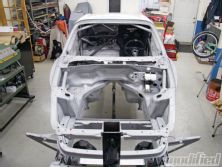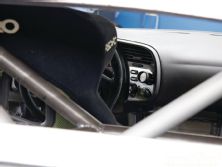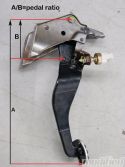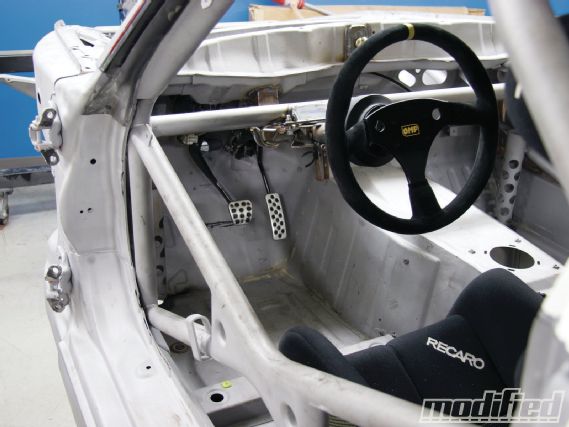 | 2002 Honda S2000 - Braking With Balance - Project S2000
| 2002 Honda S2000 - Braking With Balance - Project S2000
Our Unlimited class S2000 features many changes that Honda engineers didn’t account for when designing the braking system. One of the most influential changes is the switch from street tires to extremely sticky Advan slicks of larger diameter and width; reducing total weight, increasing rear weight distribution and substantially increasing downforce all have an impact on the braking systems ability to maintain threshold braking at all four tires. The OEM system relies on a proportioning valve and caliper piston sizing, along with rotor diameter to allow the production car to stop quickly and safely. If you don’t stray too far from the original recipe, then the OEM ABS and proportioning valve can work very well, as most S2000 owners can attest to. However, with a build like ours, the ability to fine-tune the brake balance is a must.
This brings us to the balance bar and the ENMO (Engineered Motion) remote master cylinder setup. Our original hope of fitting a Tilton triple-pedal, floor-mount setup was ruled out due to the very limited space available in the S2K. Despite mounting the seat as far rearward as possible and entertaining the idea of sinking the master cylinders within the framerail, it was still not possible to achieve a comfortable pedal position for our 6-foot-tall driver. Fortunately, ENMO designed and released a remote master cylinder setup that bolts to the OEM Honda firewall opening. (This setup will work for almost all Hondas.) It offers many of the benefits of a traditional floor-mount pedal setup while maintaining the original brake pedal, which, in our case, happens to be in the ideal location. The ENMO kit includes everything needed for the conversion, except for master cylinders and brake lines. Assembly was straightforward and everything fit as it should. We went an extra step and welded a gusset/reinforcement to stiffen the firewall and help improve pedal feel. You must remove your ABS when switching to a dual master setup because the ABS splits the output diagonally, as opposed to front and rear; adjusting the bias over the diagonals would certainly produce some strange braking behavior.
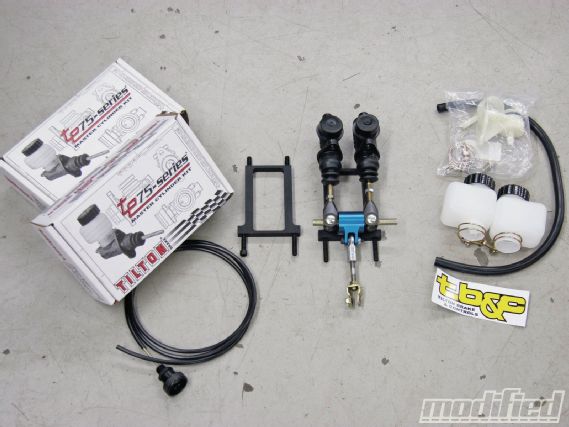 |
2002 Honda S2000 - Braking With Balance - Project S2000
|
2002 Honda S2000 - Braking With Balance - Project S2000
With the ENMO setup, we must consider the impact of removing the vacuum booster and the effect this will have on the braking system. The lack of a consistent vacuum supply with our turbo setup makes for inconsistent brake force output, but by removing the booster and ABS we saved 9 lbs and have improved the braking consistency and pedal feel. However, we’ve substantially increased the pedal force required to stop the car. The braking force required can be tuned with rotor diameter, pad compound, caliper piston sizing, master cylinder sizing and pedal ratio. Our PFC calipers and rotor diameters are already set (stay tuned for all the details), so this leaves the master cylinder sizing and pedal ratio.
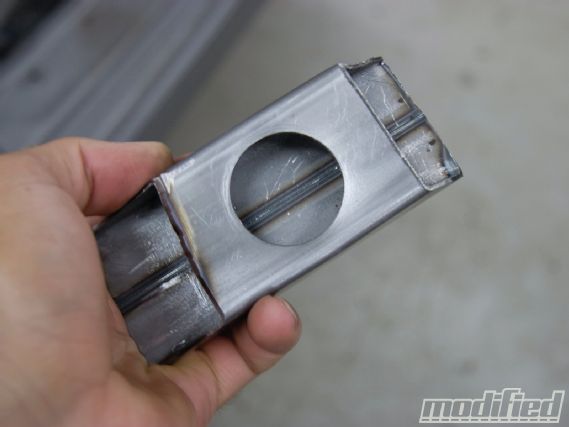 |
To ensure the pedal feel is as firm as possible, this 1x2-inch steel square tube gusset was fabricated and welded in to minimize deflection of the firewall when braking.
|
To ensure the pedal feel is as firm as possible, this 1x2-inch steel square tube gusset was fabricated and welded in to minimize deflection of the firewall when braking.
First we calculated the OE pedal ratio, which is 3.75:1. A typical racing pedal box designed for manual brakes will be around 5.5:1. To help correct for this, we opted for the 5/8-inch Tilton 75 series masters (the smallest size available). This allows for more pedal travel and helps increase line pressure relative to pedal pressure when compared to a larger master cylinder size. For example, 100 lbs of pedal force with a pair of commonly used ¾-inch master cylinders and a 5.5:1 pedal ratio will give 622 psi line pressure front and rear with the balance bar in the middle. With our 3.75:1 pedal ratio and 5/8-inch master cylinders with 100 lbs of pedal force, we’ll get 611 psi line pressure front and rear with the balance bar still in the middle. It looks like we’ll be able to generate the necessary line pressure without modifying the OE pedal ratio, and testing will determine if we need to make any changes.
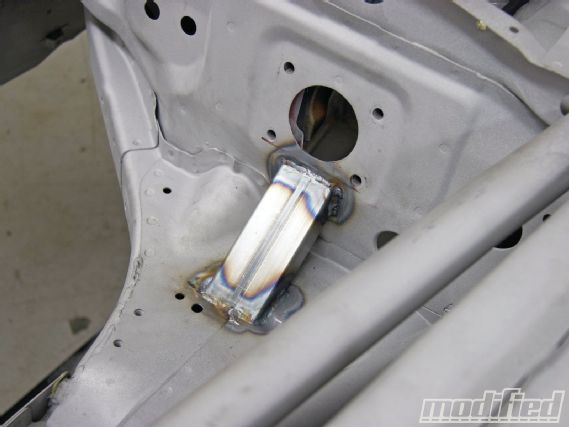 |
2002 Honda S2000 - Braking With Balance - Project S2000
|
2002 Honda S2000 - Braking With Balance - Project S2000
You’re probably wondering what a balance bar is? A balance bar is a component commonly found in racing brake systems that allows for fine adjustment between front and rear brake bias. Unlike a proportioning valve that allows rear brake force to ramp up quickly then flatten, the balance bar maintains a consistent output through the pedal application. The balance bar can also go either side of neutral with more front bias or rear bias, whereas a proportioning valve can only reduce output of the line it is installed in. With the Tilton billet remote bias adjuster installed, it’s possible to make bias adjustments while on track.
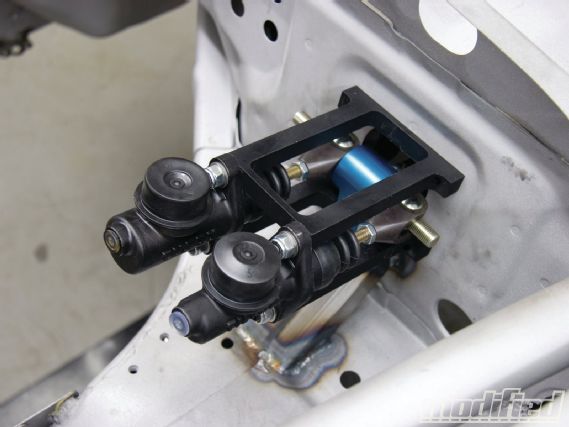 |
The balance bar uses a spherical bearing inside the blue ENMO carrier. When the threaded rod is turned, the bearing moves from left to right in the carrier changing the force distribution from the front to rear master cylinder, adjusting the brake bias.
|
The balance bar uses a spherical bearing inside the blue ENMO carrier. When the threaded rod is turned, the bearing moves from left to right in the carrier changing the force distribution from the front to rear master cylinder, adjusting the brake bias.
Using the balance bar efficiently is something a driver must learn to do. It is often difficult at first to determine which wheel locked up and what to do about it. Typically, a front wheel lock will induce an understeer condition, while a rear lockup will induce an oversteer condition. Applying more rear brake bias will help avoid a front lockup and vice versa. The balance bar can be used throughout a session to maintain optimum brake distribution as fuel load decreases (with a rear located fuel cell this will require less rear bias) or if the car is experiencing uneven tire wear front to rear. (Using up the rear tires may require less rear bias.) If track conditions change and grip reduces like when it starts to rain, it will be necessary to add more rear brake bias. While this may seem like the worst thing to do in the rain, it will greatly improve your braking ability. As grip is reduced, so is the longitudinal load transfer we can generate in braking. Consequently, we need more brake bias to the rear as that is where the load is.
With the ENMO brake setup install complete, we’ve managed to keep our brake pedal in its ideal position while achieving the benefits of a full racing pedal box. We’ve been logging lots of hours on the S2K chassis as of late, and even though it’s hard to see the progress some days, paint is quickly approaching. Stay tuned.
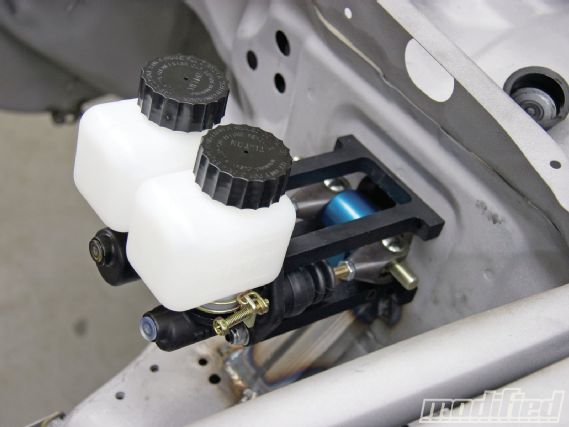 |
The Tilton 75 series masters include an array of reservoirs — here we have the larger ones fitted, which ensure adequate capacity and require less frequent top-ups during bleeding.
|
The Tilton 75 series masters include an array of reservoirs — here we have the larger ones fitted, which ensure adequate capacity and require less frequent top-ups during bleeding.
The lack of a consistent vacuum supply with our turbo setup makes for inconsistent brake force output, but by removing the booster and ABS we saved 9 lbs and have improved the braking consistency and pedal feel.
Sourcebox
Enmo
Remote Master Cylinder Setup
enmo.ca
Tilton Engineering
Master Cylinder
tiltonracing.com

